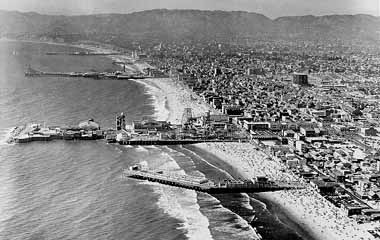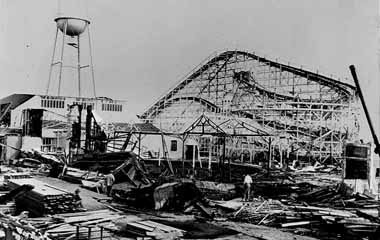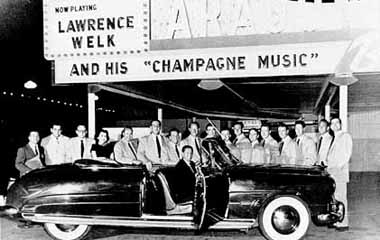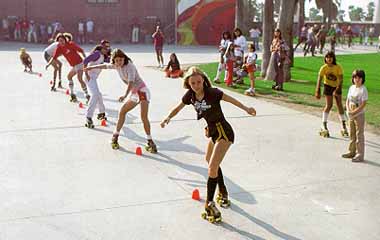









|
|

 |
After the amusement piers were closed, Venice became deserted - Notice the remaining stores blocking the ocean view on the left
|
Annexation, Depression, Ruin and Rebirth (1930 - Present Day)
Distraught by the inability of the City Council to adequately govern Venice, the residents held an election and the voters decided that Venice be officially annexed to the City of Los Angeles. It was like Los Angeles annexing Disneyland. The city, which never cared for Veniceís honky tonk atmosphere, started to dismantle the amusement industry. It began with the removal of the miniature railroad and filled in the majority of the canals to accommodate increased automobile traffic. The canals South of Venice Boulevard remained intact and today they still mirror the scenic beauty of yesteryear. The city converted the bankrupt Sunset Pier into a municipal bathing pavilion.
 |
Venice becomes an oil boom town - View of the Grand Canal in 1930
|
In 1930, oil was discovered on the Venice Peninsula. Within a year, 148 oil wells were producing over 40,000 barrels of oil daily. Jobs were created, but environmental destruction was wide spread and polluting the surrounding residential area and beaches.
In 1932 the Depression hit hard. Various Venice banks went bankrupt and the Venice Pier went into receivership. However, when liquor consumption became legal again and bingo games were modified into a game of skill, the economy benefited.
 |
A 1941 aerial view looking north shows the Sunset Pier, Venice Pier and Ocean Park Pier before they were demolished
|
When World War II started, it affected Venice and it's seaside amusement centers. A blackout was instilled which allowed only daytime use of the piers and their attractions. National Guardsmen patrolled the beaches in search of enemy submarines and ships. During the daytime, Venice became a major draw for sailors and soldiers on weekend leave. Country Western and Swing music echoed from the dance halls and casino lounges. The evening curfew was eventually lifted in 1944 and life in Venice returned to normal.
 |
Los Angeles City orders the Kinney Company's Venice Pier to be closed and demolished - 1946
|
When the Kinney Pier's lease expired in 1946, the Los Angeles Parks and Recreation Department declined to renew the lease, although the company had just recently refurbished the pier entrance and repaired the aging deck. Profitable or not, the cityís plan was to widen the beaches thus removing all piers. Attempts were made to extend the lease for another year, but the Parks department refused and the pier closed on midnight April 20, 1946 and the pier was ordered to be dismantled. The Ocean Park Pier, however, thrived in the late 50's after it was converted to a nautical theme park. It remained in existence until 1967.
 |
Lawrence Welk in car at entrance to Aragon Ballroom. - 1953
|
During the 50's, the Lawrence Welk Band brought a new resurgence of business to the ailing dance halls and piers. A televised show made Welk a national celebrity. But by the end of the decade, pawn shops and liquor stores had replaced the souvenir shops and bingo parlors, and tourists were nowhere to be found.
Venice was in a severe state of decay and in desperate need for redevelopment. In the early 60ís, the city instituted a policy of "Code Enforcement" where all buildings had to be upgraded to current building standards. However, they made it impossible for owners to obtain loans. 550 buildings, many along the ocean front and in the historic Windward business district were demolished. A lawsuit eventually stopped Veniceís wholesale destruction.
A new group of people had made their way into the confines of Venice in the 60ís. The "Beats" as they were referred to brought a Bohemian life style. Life centered around art, poetry and new-jazz. Venice was tolerant of their life styles and they gathered in the local coffee houses. Where the Beats left off the Hippies took over. The flower children of the 60's flocked to Venice to experience free expression during their "summer of love." The canals witnessed pot parties, love-ins and drunken frenzies. Several riots occurred during outdoor beach concerts with resulting arrests.
Venice experience a rebirth in the 70's but not as a major tourist destination. The focal point was on maintaining the character of Venice so as not to chase out the low income population. In 1972, the city constructed an 18 mile bicycle path adjacent to Ocean Front Walk which extends from Torrance to Santa Monica. The new visitors were local residents riding bikes through the depressed Venice, bringing it new life. In 1974, nude sunbathing was actually permitted north of the Pavilion. It caused such a stir that the City of LA voted 14 to 1 to ban the fully exposed from sun bathing. This brought a new sight to Venice, the Los Angeles Police dressed in blue shorts and T-shirts enforcing the new law.
 |
The skating craze of the 70's brings a resurgence to Venice - Photo by Jeffery Stanton
|
In 1976, with the invention of the polyurethane skate wheel, outdoor skating became the rage. Venice's wide Ocean Front Walk and bicycle path made it an ideal location for skating. Vendors began renting roller skates from outdoor lots along the ocean front and tourists flocked to the area to experience the new sport. With the crowds came street performers and sidewalk artists along with T-shirt and sun glass stands. The Los Angeles city mayor deemed Venice "the roller skating capital of the World." Venice had become a tourist attraction again.
 |
Murals were painted on buildings throughout Venice in the late 70's - Photo by Jeffery Stanton
|
In the late 70's and early 80's, Venice saw the likes of mural art. Buildings all around town were brilliantly livened up with scenes depicting landscapes, everyday life and tributes to Venice artists such as Jim Morrison of the legendary band, The Doors. With an onslaught of street artists, vendors, musicians, body builders, palm readers and live television coverage during the 1984 Summer Olympics, Venice began receiving visitors from around the world on a daily basis.
Venice history is still being written. Today Venice is keeping with its colorful tradition as being the number one seaside destination on the West Coast. Visit Venice and be a part of history.
Return to Venice History, Part 1
For a comprehensive history of Venice, see Jeffery Stantonís History of Venice educational site.
Back to the Venice Home Page...
This page was produced by the Westland Network
Copyright © Westland Network 1996-2009 - All Rights Reserved
|







